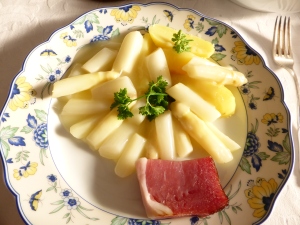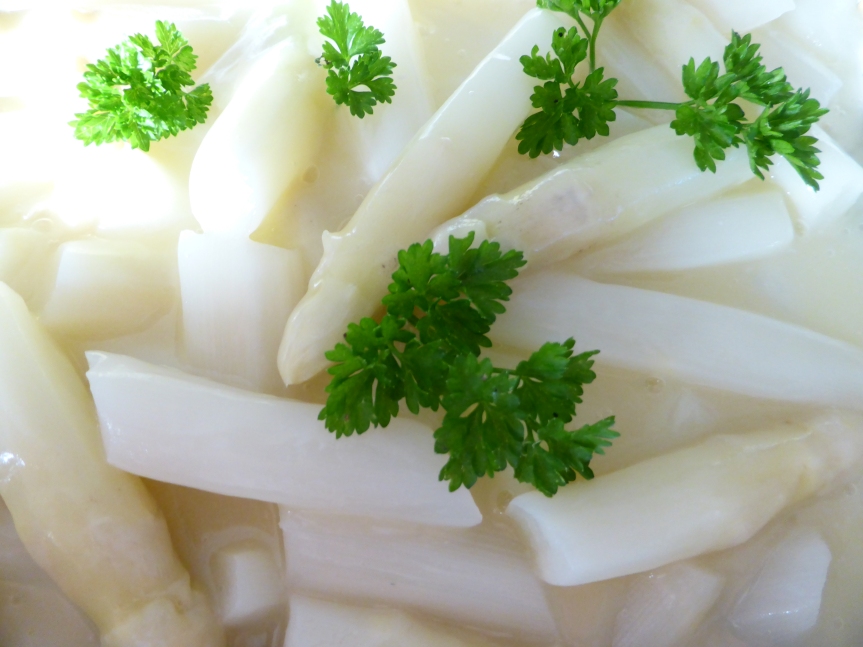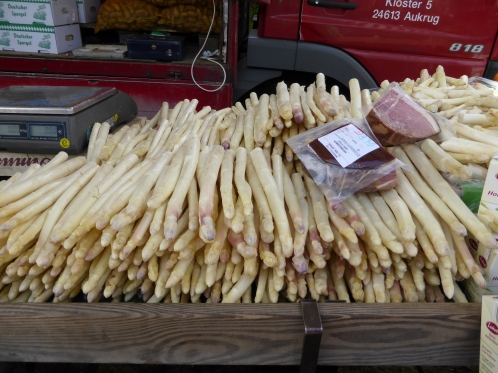As long as I can remember, my mother served white asparagus for Sunday dinner during late spring and early summer. I hated it! It was not until I was nearly grown-up that I started to understand what all the fuss was about.
White asparagus are shoots growing off the root of the asparagus plant. The white spears are 12 to 16 cm long and used to be called the King’s vegetable, for until the days of modern farming only a selected few could afford to buy it. The white shoots grow underground and must be cut before they break through the surface. It is not possible to harvest asparagus by machines; farm helpers have to get up early in the morning to cut each shoot by hand. This explains why asparagus is not a cheap vegetable and even though almost everybody can afford it these days, it is still considered a precious food.
It is, of course, possible to get imported asparagus out of season, but most Germans consider only locally grown white asparagus as “the real thing”. Asparagus tastes best when it is fresh and it shouldn’t be kept in the refrigerator for more than two or three days, wrapped in a damp kitchen towel. Many people don’t buy asparagus in the supermarket but drive out to nearby farms on Saturday or Sunday morning to buy it immediately after it has been cut. City people will find fresh asparagus on the markets, where farmers from the area offer their food, or they can buy it from small stores that pop up near underground stations and at street corners as soon as the asparagus season begins.
The asparagus season lasts from about mid April to the 24th of June. Thanks to the early and warm spring we are having this year, the season started unusually early this year, so that we had our first asparagus at Easter.
As soon as the first German asparagus is available, conversations at work, among friends and neighbors circle around questions like where to buy the freshest asparagus and whether it is better simply with butter or with a sauce Hollandaise.
My partner, who is Norwegian, can’t quite understand, why Germans like asparagus this much. In his opinion, the fine, subtle aroma of it is nice but not exiting. That might be true, but for Germans asparagus is not just a healthy vegetable, asparagus is part of the German lifestyle. It is the topic to talk about, all restaurants and inns offer special asparagus dishes, some villages have asparagus festivals, even electing a young woman as ‘Asparagus Queen’. There is complete agreement among Germans, that one has to eat the delicious white spears as often as possible while they are available.
However, I believe there is another reason that makes asparagus so special: it signals the end of the cold season and the beginning of summer. It is the first local summer vegetable available and it can first be harvested when the weather has turned mild. During the six to eight week long asparagus season, nature is changing dramatically, trees and flowers start blooming and blossoming, people are turning to more outdoor activities and looking forward to the joys of summer. Everything seems to be lighter, easier and happier. Asparagus dishes reflect this spirit of early summer, they are light, low in calories, easy to prepare and you will not feel as stuffed as after eating a typical German winter dish.
The end of the asparagus season is on the 24th of June and you will not be able to purchase German white asparagus on the 25th of June. The 24th is a date rooted in German pagan tradition, the night from the 23rd to 24th of June being , Johannisnacht’, the German version of midsummer. From that day it will be at least 100 days until the first frosts occur, enough time for the plant to grow and thus ensuring that there will be a rich harvest during the next asparagus season.

Here are my favorite ways of having it:
I peel the asparagus and wrap it in a cool damp kitchen towel while boiling the asparagus peel with a bit of salt salt and one or two pinches of sugar for about 20 minutes. I do this so I can gently simmer the asparagus spears in the stock afterwards,for it enhances the flavor beautifully. After 10 to 15 minutes, depending how thick the spears are, the asparagus is ready to eat.
I serve it with new boiled potatoes, lot’s of melted butter and a big chunk of smoked ham.
I also like the way my mother makes it, even though most gourmets would have a fit over this rather simple way of doing it:
She cuts the spears in 3 – 4 cm long pieces before putting them in the stock. The pieces should just barely be covered by it. After 10 – 15 minutes she adds a large piece of butter and thickens the stock with some cornflour. She then serves it with boiled potatoes and ham or with a Schnitzel, using a steak of turkey breast or a lean pork steak she first turns in white flour to which she has added salt and pepper, then she rolls it in some beaten up egg and finally in bread crumbs before frying it in oil.
Many people keep the asparagus stock to use for a soup (very nice in chicken soup .-)) and some even drink it, because asparagus has a dehydrating effect. It has hardly any calories, which, at least for me is an excuse to eat as much of it as I can during spring.


